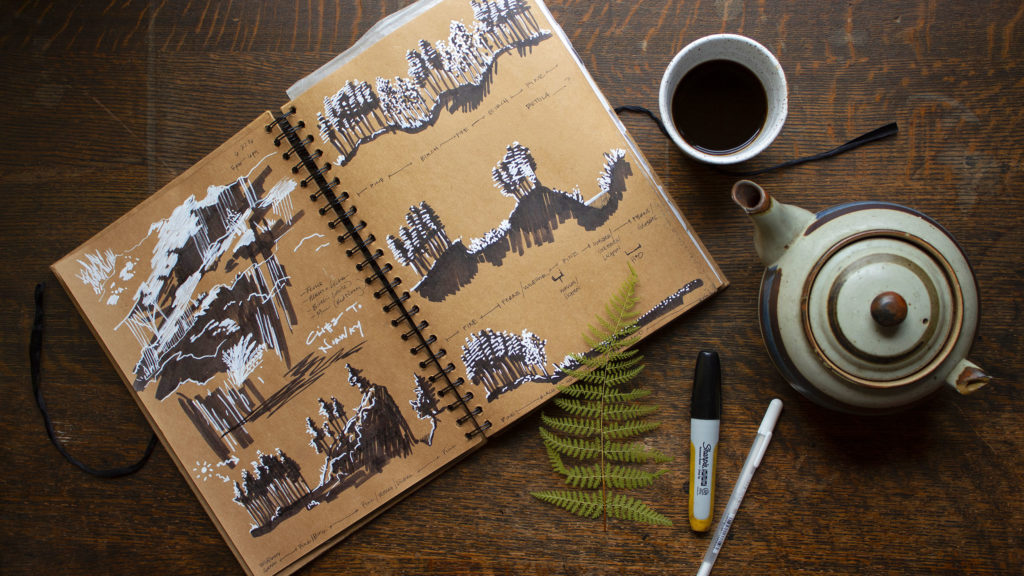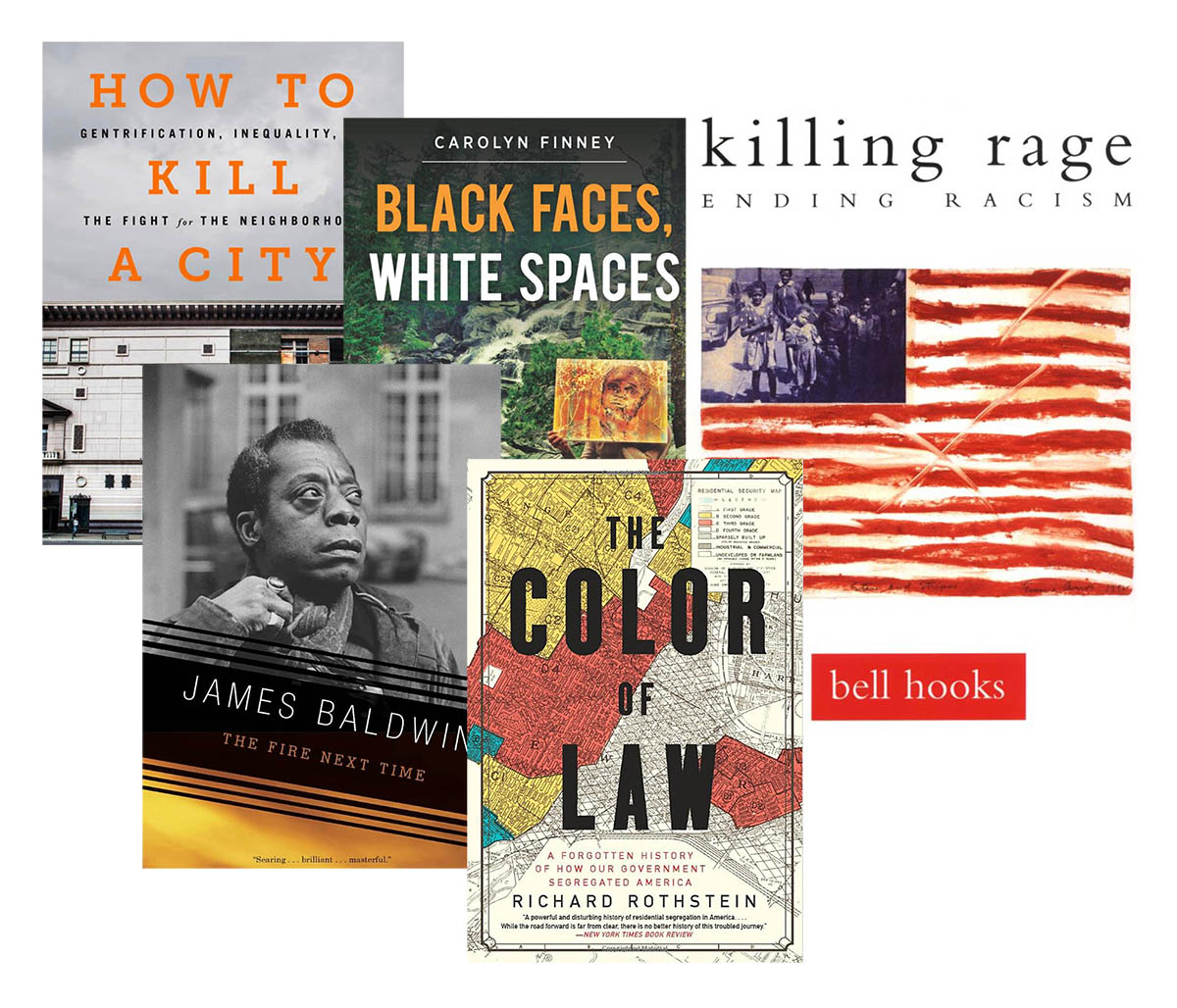A Behind-the-Scenes Look at Interrogative Design: Selected Works of Krzysztof Wodiczko, through Seven Candid Conversations
Listen to Krzysztof Wodiczko and the curator Dan Borelli discussing six of the seventeen projects featured in the exhibition Interrogative Design: Selected Works of Krzysztof Wodiczko.
Spanning five decades, the artistic practice of Krzysztof Wodiczko is well known for public projections that offer marginalized people an opportunity to inscribe their lived experiences onto public squares, institutional buildings, wartime monuments, and other pieces of civic architecture. Interrogative Design: Selected Works of Krzysztof Wodiczko, on view through April 8th in the Druker Design Gallery, presents one of the most vital artistic practices of the 21st century. Here, the artist offers insights into some of his most iconic works through conversations with curator Dan Borelli.
Learn more about Krzysztof Wodiczko’s project Homeless Vehicle:
Learn more about Krzysztof Wodiczko’s project Poliscar:
Learn more about Krzysztof Wodiczko’s project The Real Estate Projection:
Learn more about Krzysztof Wodiczko’s project Alien Staff:
Learn more about Krzysztof Wodiczko’s project El Centro Cultural Projection, Part II:
Learn more about two of Krzysztof Wodiczko’s projects: Personal Instrument and Dis-Armor
Land for a City on a Hill: Alex Krieger’s iconic tour of Boston
Watch as Alex Krieger, professor and former chair of the Department of Urban Planning and Design, takes viewers on his iconic tour of Boston. Stopping at locations key to the growth of the city—from East Boston, which was once five islands that were consolidated in the late 18th to 19th century, to the Shawmut and South Boston Peninsulas—Krieger speaks of the historic and contemporary geographical, infrastructural, and racial conditions of Boston, a city in “constant need to create land.”
Work in Progress: Edgar Rodriguez’s Cross-Laminated Timber Experiments
Edgar Rodriguez (MArch ’20) describes his final project for the option studio “Mass Timber and the Scandinavian Effect” led by Jeniffer Bonner and Hanif Kara, spring 2020.
The Nexus Podcast
As countless industries and sectors reckon with the aims articulated by the Movement for Black Lives and other aligned groups, the African American Design Nexus is on a mission to elevate the work and roles of Black designers. Founded in the wake of the GSD’s first Black in Design Conference in 2015, the Design Nexus is a collaboration between the school’s African American Student Union and the Frances Loeb Library. It’s a preeminent resource for those interested in the intersection of Blackness and design practices throughout the built environment as well as those represented in “public art, fashion, music, movies and other media.”

Now, its mission will be further animated by a new podcast featuring Black scholars, writers, designers, and educators. As hosts of The Nexus , GSD students Tara Oluwafemi and Caleb Negash aim to ensure that the podcast records and preserves the legacy of Black designers working today, and they plan to push the understandings of the boundaries of design in the most expansive ways possible. They anticipate that The Nexus will introduce listeners to designers who represent exciting interventions within the field, but who may not be household names yet. For Oluwafemi, for example, dream guests include Nigerian designer Mowalola Ogunlesi and acclaimed artists Toyin Ojih Odutola and Jacolby Satterwhite.
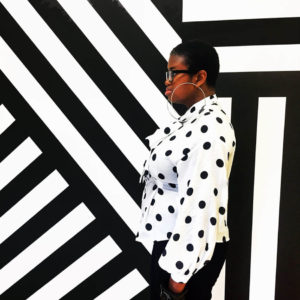
The Nexus’s inaugural episode features Boston-based architect, filmmaker, illustrator, and children’s book author Aisha Densmore-Bey . It is a conversation that ranges from what it means to be a polymath, to Densmore-Bey’s personal influences, to her relationship to art, joy, and beauty. The mood of this dialogue—an intimate, nuanced inquiry that critically traverses the geographies of design—is illustrative of what Oluwafemi and Negash seek to capture throughout the entire series. As the two continue to assemble a dynamic roster of interviewees, including Stephen Gray, De Nichols, and Bryan Lee Jr., they are looking forward to playing, experimenting, and sharpening their own skills as storytellers.
Ultimately, The Nexus will add to the broader intellectual ecology that is the African American Design Nexus and will contribute to the Loeb’s ongoing open access bibliography that makes available key texts related to “the intersection of race and design.” This effort of documentation, historicization, and preservation, as Oluwafemi and Negash explain to me, will be strengthened by the voices they plan to amplify and celebrate.
Summer Scholarship at the GSD
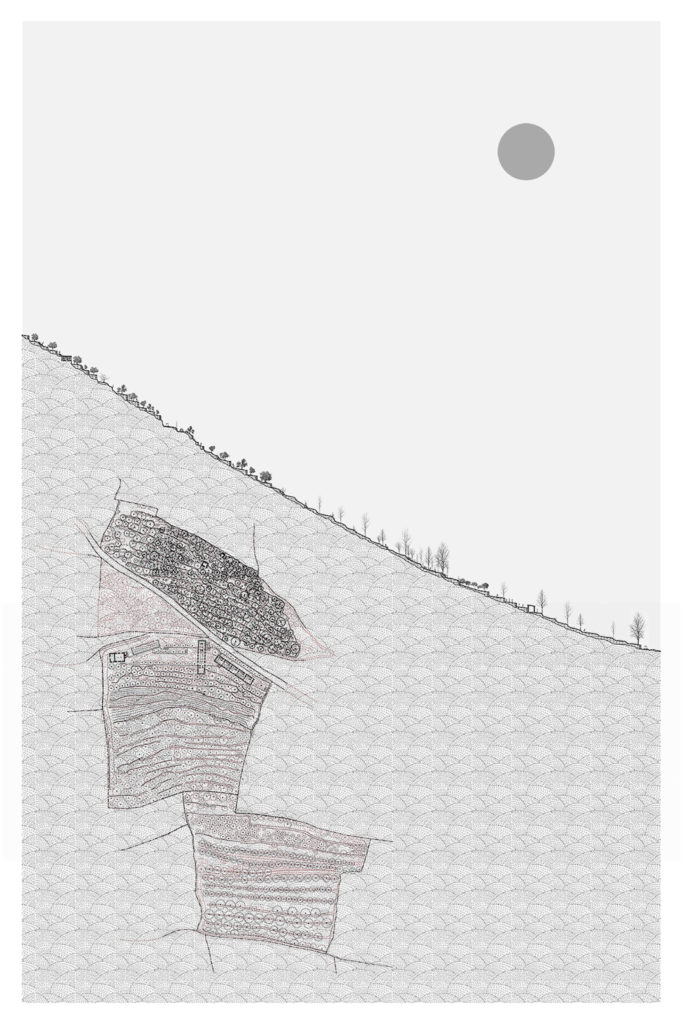
Existing Section and Proposed Interventions for an Agricultural Campus for La Carboncella, by Nicolás Delgado Alcega (MArch ’20)
The GSD introduces new summer opportunities and recharges long-standing ones, aiming to foster a productive summer despite pandemic-induced complications.
Cooperative farm organizations for BIPOC communities. Pandemic-proofed parks, offices, sidewalks, and restrooms. New strategies to ensure accuracy of census and GIS data in African cities.
While varied, these topics are united by design’s potential to intervene in precise ways, as well as by a fresh urgency given the consequences of the COVID-19 pandemic. They are among the 227 investigations that students and recent graduates will pursue this summer as the GSD introduces new avenues for academic and professional enrichment, and continues to consider the direction and process of design research in an altered global environment.
Amid office closures and precipitous unemployment levels, traditional summer work and learning opportunities have evaporated—especially for students and recent graduates. This dynamic introduces a double-headed challenge: how might students continue to advance their ideas while also gaining professional experience?
“Students have always used summer months to expand on what they’ve learned, by working in offices, partnering with peers on design competitions, traveling to see projects in situ, or advancing research,” says Sarah M. Whiting, Dean and Josep Lluís Sert Professor of Architecture. “The pandemic has eliminated many of these valuable opportunities, so we felt that it was critical to support our students, including those graduating into this difficult moment.”
At the heart of the GSD’s effort is the new Student Emergency Fund (SEF), launched on March 10, which provides summer research grants for GSD students and 2020 graduates, and ameliorates some of the logistical and practical complications stemming from travel restrictions. SEF’s research grants offer latitude and elasticity for students: there are no grades or credits to be pursued, no formal supervision required—though each recipient will offer a written summary of their research at its conclusion. In order to assist students in advancing their individual research, the Office of the Dean bolstered the research funds raised via SEF efforts with a matching donation.
Amid office closures and precipitous unemployment levels, traditional summer work and learning opportunities have evaporated—especially for students and recent graduates. This dynamic introduces a double-headed challenge: how might students continue to advance their ideas while also gaining professional experience?
“This was an opportunity, as a GSD family, to wrap our arms around our current students and take a specific action in the unprecedented moment of a global pandemic,” says Peggy Burns, Associate Dean for Development and Alumni Relations. “SEF highlights that the GSD is very much a community: alumni taking action to help support students, with our own faculty among those alumni who have so generously offered various forms of support.” The school’s community of alumni and friends has contributed directly to the SEF while also responding with enthusiasm to requests for increased internship opportunities for GSD students.
The GSD is also reshaping traditional summer offerings in order to pave new pathways toward students’ professional enrichment. Irving Innovation Fellows, selected annually, will collaborate with the GSD’s Innovation Task Force over the summer in order to conceptualize a digital learning environment more nuanced than the one generated this past spring. The school is also providing additional funding to enable teaching assistants to begin their Fall 2020 work during the summer, so they can provide support for courses pivoting to remote teaching and learning in the fall. And it is encouraging faculty to continue hiring students for summer research and design work.
The 227 students and recent graduates who will pursue research this summer are covering a range of topics and perspectives, many of which have been influenced by the ongoing COVID-19 pandemic. A snapshot of some of these projects and their early-stage germination reveals what GSD students have been pondering over the past few months, how they hope to make use of this unconventional summer, and why they consider their research essential given today’s conditions.
The future of co-working spaces
For years, Francisco Brown (MDes CC ’20) has been studying the real-estate models behind co-working spaces, as well as the broader implications of the so-called sharing economy. As more and more businesses shifted to remote-work arrangements this spring, Brown’s question suddenly transformed: instead of “How do co-working spaces work?,” he was asking, “Will they work at all?” And, if they can’t: What happens to all of that real estate?
“Even though co-working has evolved in a variety of operational and business models, co-working is, in principle, about the community, and its host spaces are about collaboration and proximity,” Brown observes. “The current conditions beg the questions: How can a business model that revolves around renting dense shared-office space stay afloat with social distancing rules and in the advent of what may be the worst economic crisis in a century? How can design research explore new ways to reuse, adapt, and speculate about these spaces in the face of the most significant cultural and economic shift in our times?”
To address these questions, Brown will work alongside research advisor Jacob Reidel, Assistant Professor in Practice of Architecture and a senior director at co-working start-up WeWork. Brown aims to first collect relevant news and data around regulations, analysis, and ideas on design responses to social distancing rules. He then plans to interview academics, co-working-space managers and designers, and organizational scientists to discuss the opportunities and challenges that co-working spaces are facing. Ultimately, he will consider design adaptation and typological hybridization for the millions of unused square footage of space that co-working chains currently hold.
Adapting Hawaii’s comfort stations in the face of COVID-19
Like offices, public restrooms are a cornerstone of urban and civic space, and they, too, have been stress-tested by the COVID pandemic. Kaoru Lovett (MArch ’20) had been researching Hawaii’s so-called comfort stations as a design expression of utilitarianism, one upon which architectural identities have been constructed. The comfort stations, which were conceived during the postwar boom years of the 1950s and 1960s, offered local designers an opportunity to bring regional materials and era-specific aesthetics into what would otherwise be generic, utilitarian public bathrooms.
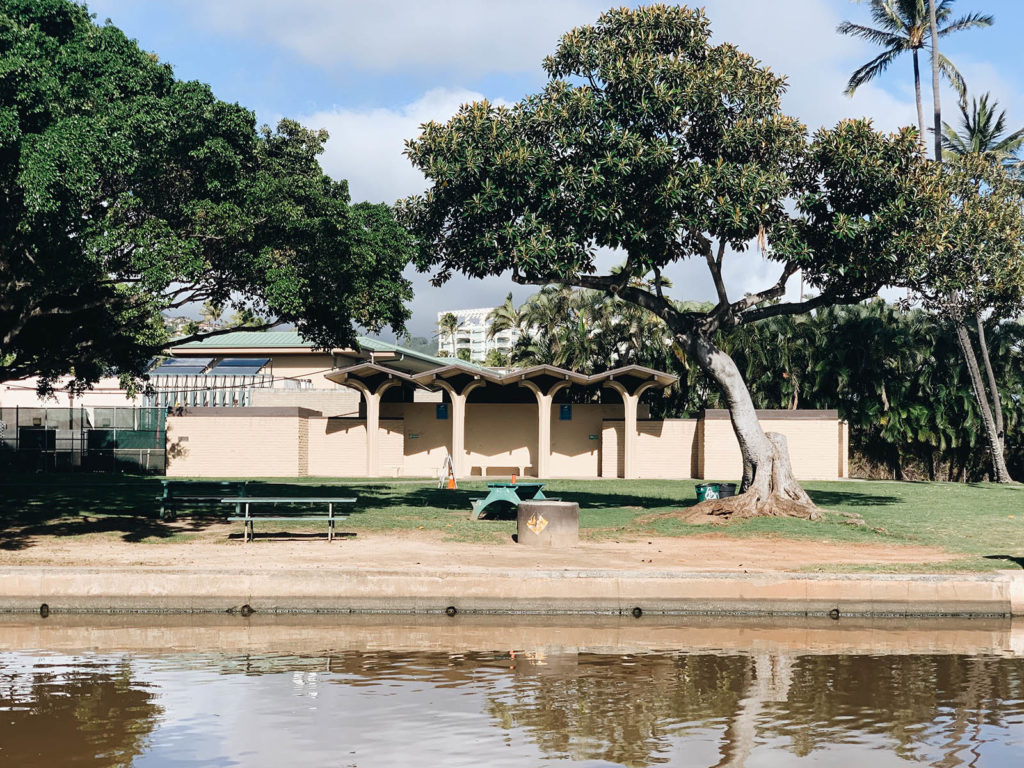
Waialae Beach Park comfort station. Photo by Kaoru Lovett
“The public comfort stations of Hawaii are an interesting precedent, as the scale and timeline of the public project was immense, nearly 200 pavilions over the span of 30 years,” Lovett says. “These pavilions were affiliated with a larger effort to shed light on the budding island destination, establishing some of the foundational work upon which the architectural identity of Hawaii is built.”
While Lovett had initially researched the relationship between the identity and the construction of comfort stations, now he’s wondering whether their inherent utilitarianism can satisfy today’s newly charged public-health concerns. Like Brown, Lovett has watched his original research interests reshape and gain dimension in light of COVID, though not fundamentally transform. This summer, he will examine—from afar—how to adapt Hawaii’s comfort stations to accommodate post-COVID standards of sanitation and social distancing.
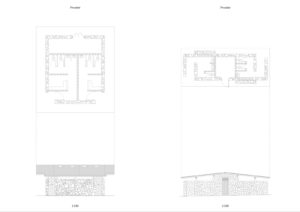
Pupukea Beach Park comfort station, and the Liliuokalani Garden comfort station drawn up referencing construction documents provided by the Honolulu Department of Design and Construction.
“My earlier interest with these public facilities as architectural ‘image’ models has coincided with the attention brought on by recent events,” Lovett says. “This creates an opportunity to approach these pavilions with a particular interest: construction logic and building imagery as strategies for resolving issues of public health.” Given Hawaii’s current plans for phased reopening of public spaces, the attendant need for safely designed public restrooms is growing in urgency.
Lovett anticipates that strategies revealed through his research process—whether they be methods of organization, construction, or technology—will find application in public restroom facilities more broadly. “My aspirations are that the specificity of this precedent will act as a platform to engaging in a larger discourse on public health and sanitation through our post–COVID-19 society,” he says.
Reimagining online space
For Emma Ogiemwanye (MUP ’20), a long-standing research interest in virtual presence has been supercharged in recent months. After a five-year stint at Google, Ogiemwanye arrived at the GSD aiming to explore how urban planning theory and practices might be applied to the Internet in order to help make digital spaces safer, more just, and more equitable. In other words, she wanted to consider how the skill sets of an urban planner, trained in analyzing complex issues of policy and governance and in addressing needs of communities, might be applied to the design of online spaces.
As part of her GSD thesis, Ogiemwanye created a taxonomy of strategies that some Instagram influencers invoke to subvert the normative performances featured on the platform. Her research centers on Black women influencers and explores the myriad ways they navigate and reimagine online space. She has taken particular interest in how these influencers have pulled digital levers to elevate joy, activism, and access to social capital and art through their content.
Ogiemwanye observed that COVID has pushed much of cultural life online. And it has simultaneously revealed health disparities across race, especially as Black Americans are suffering and dying in disproportionately high numbers. In that complex tangle, Ogiemwanye saw the dual narrative so familiar to Black America, queer people of color, and other multiply oppressed communities: creativity and ingenuity emerge in the face of danger and pain.
“Inequalities in access to safety and well-being are now plainly seen and are finally being decried in our physical world. My work stands to point out how dominant online platforms perpetuate these same extractive logics to maximize profit,” Ogiemwanye says. “I hope this transformative moment will result in us reimagining many systems, from housing to healthcare.”
With the support of faculty advisor Lily Song, Ogiemwanye plans to continue descriptively mapping social-media activity by observing how people move and interact online. She believes that she can help encourage what she describes as “more liberatory possibilities” for digital spaces. “This is, in part, a project to build better digital ecosystems as we increasingly spend more time online, while also capturing a snapshot of this unique moment in human history,” Ogiemwanye says. “Online platforms should be included in any list of structures requiring reinvention.”
New forms of food sovereignty
The pandemic has revealed numerous social structures and behaviors that require such reinvention, or at least reconsideration. Throughout the world’s food systems and networks, for example, changes in both work and consumption patterns introduced logistical logjams and supply shortages, highlighting ongoing concerns over labor, supply, equity, and security. Over the course of her GSD studies, Adriana David Ortiz Monasterio (MDes ADPD ’21) has been investigating food sovereignty—explained broadly as the right of a community or a people to define and control the systems and policies that produce the food they eat. She has focused especially on the diversity and conservation of heirloom seeds.
A Fall 2019 GSD course, “The Landscape We Eat” with Montserrat Bonvehi Rosich, had inspired David to assess the full network of food chains and their inherent social and environmental impacts. And Malkit Shoshan’s Spring 2020 studio, “Interdisciplinary Art and Design Practices,” motivated David to apply design in order to engage social issues.
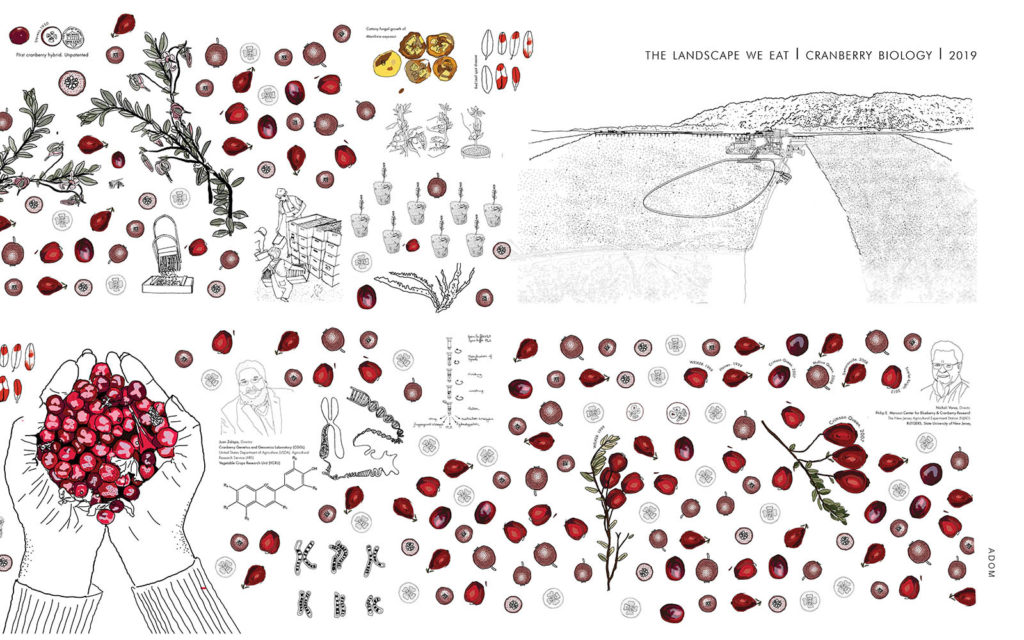
Cranberry Biology Analysis from The Landscape We Eat course
As COVID brought about food instability and other problems throughout global food systems, David saw her ongoing interests come into sharper relief. “This is a crucial moment to delve further into the relationship between food supply chains and food sovereignty for a nation,” she says. “The security of our food sources and availability is critical for the future of our communities. Understanding our food chains means understanding the origins of our food, the seeds used, chemicals, soil, water, field ownership, the architecture of the system, transport, storage, and human labor. I am interested in speculating on new forms of food networks for the city that can result in food sovereignty for communities in danger of famine, and allow for better ways of dwelling with care in the future.”

Comparison of the natural interactions of food systems, specifically the Three Sisters (corn, bean, squash), with the built environment today
Based in Mexico City, David will engage that city of 22 million people as a sort of research site while she consolidates previous quantitative research and begins applying it to case studies. She aims to organize her summer research according to the different food-supply spaces of Mexico City—including supermarkets, temporary markets, and organic farmers’ markets—while layering in a COVID-specific frame: food systems before, during, and after a pandemic condition. She hopes to produce a booklet cataloging methods of ensuring food sovereignty for Mexico City, and ideally for other cities and regions around the world. Bonvehi and Shoshan will advise David throughout her study.
Courtyard typology in the Italian countryside
Meanwhile, other students are taking up the holistic urban development process itself as a question worth interrogating. Nicolás Delgado Alcega (MArch ’20) has spent much of his last three semesters at the GSD researching cities and towns that dot the Italian countryside, with their medieval urban cores and attendant issues of agricultural land abandonment, soil erosion, depopulation, and disinvestment. Seeking adaptation strategies for these communities, he has seen a rising interest among younger generations in agriculture, motivated by economic downturns in cities, environmental degradation, and the loss of cultural heritage.
The research that Delgado Alcega develops over the summer will offer a detailed analysis of specific architectural and urban issues that his previous work revealed to be important in the socioeconomic transformations of the site of study. Aiming for concrete solutions, he will test whether the courtyard typology, as an intervention, might resolve or address issues of accessibility, structural stabilization, and sustainability that have emerged over his research thus far.
In particular, Alcega will take up the Italian town of Vallecorsa as a case study, in which he will propose employing the urban medieval block to accommodate emerging ways of life, programs, and pragmatic needs. Alcega benefits from testimonies and other research he gathered during a two-week site visit to Vallecorsa last winter, and he is grateful for the time and space in which to carefully process and strategize the research he has in hand.
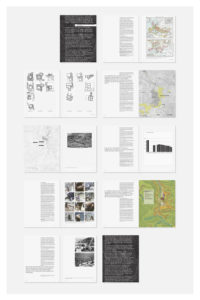
Vallecorsa Research Book Produced With J. Silvetti
Alongside his collaborator, Ginevra D’Agostino, a student at MIT’s School of Architecture and Planning, Delgado Alcega plans to continue a partnership with Vallecorsa’s Cooperativa Agricola La Carboncella, a local organization dedicated to rethinking the future of the area’s historic landscapes. With D’Agostino, he also hopes to incubate a related start-up venture through the Harvard Innovation Lab. Jorge Silvetti, the Nelson Robinson Jr. Professor of Architecture, will remain involved in Delgado Alcega’s work over the summer, having advised the project over several semesters.
With the SEF’s support, these threads of inquiry may extend from Delgado Alcega’s previous coursework and into tangible plans and strategies for local communities. “These research grants have offered a great opportunity to further some of the work we’ve undertaken at the GSD, and begin to transition it toward applications that could have a place in addressing specific challenges through practice,” Delgado Alcega says. “The research grant will give me the unique opportunity to transition from academia to practice in a more meaningful way in the midst of today’s uncertainty.”
There is still time to support the GSD Student Emergency Fund. A donation of any amount will have a direct impact on student research and/or emergency needs. Give today.
Four Native Designers Make GSD History
This story originally appeared in the Harvard Gazette as “Architects of their future” by Jon Chase/Harvard Staff Photographer (June 1, 2020).
All photos at Gund Hall were captured prior to the building’s closure in March 2020. For the first time in its history, the Harvard Graduate School of Design (GSD) has four Native American students enrolled. Design and architecture schools across the country have historically had few Native students, with no more than a handful at a particular school at any given time. And out of over 90,000 working architects in this country, only a small percentage are Native American, notes GSD student Elsa Hoover. (A 2015 American Institute of Architects diversity report listed American Indian or Alaska native at 1 percent, based on survey responses.) Elsa Hoover, Zoë Toledo, Heidi Brandow, and Jaz Bonnin are the four at Harvard, and together they have formed the Harvard Indigenous Design Collective to promote design by and for Indigenous communities, which is foundational to the history, theory, and practice of design fields on Native homelands.
Jaz Bonnin (MDes Critical Conservation ’21) in the library at Gund Hall. Bonnin is Yankton Sioux, Blackfoot, Irish, Danish, French, Panamanian, and Mexican Native descent. “I am enrolled in a master’s of design program, focusing on issues of conservation and preservation. My goal is to specialize in designing atriums, courtyards, and indoor-outdoor garden spaces for small-scale residential, commercial and adaptive-reuse clientele,” she says. Jon Chase/Harvard Staff Photographer

Jaz Bonnin with a small model enclosed in glass. “I am the first woman in my immediate family to graduate from high school and then college,” she says. One notable family member of Bonnin’s was Gertrude Simmons Bonnin (1877-1938), a teacher, poet, author, classical violinist, and political activist for indigenous rights. She studied at the New England Conservatory in Boston and co-wrote the first — and possibly only — known American Indian opera. Photos by Jon Chase/Harvard Staff Photographer; Gertrude Käsebier/National Museum of American History
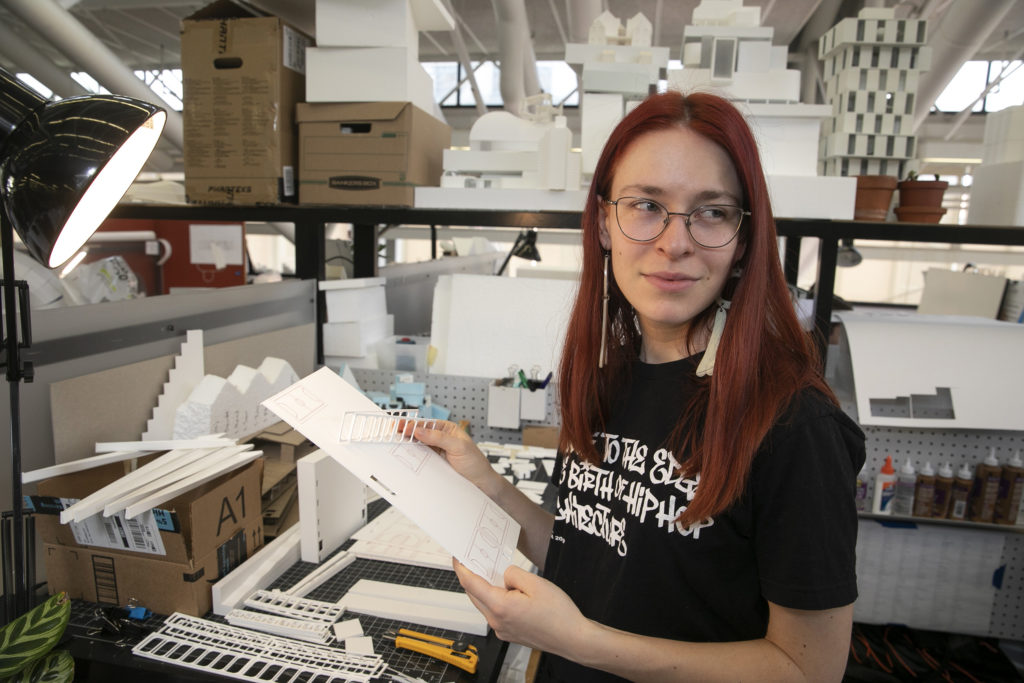
Elsa Hoover (MArch ’23) works on a model at her Gund Hall desk. Raised in Minneapolis, she is of Anishinaabe First Nations and Finnish descent. She currently writes about theory and the history of indigenous rights, resource extraction, and conflicts over oil and water. Jon Chase/Harvard Staff Photographer

These maps come from a set of 10 prepared for the book “Empire’s Tracks: Indigenous Nations, Chinese Workers, and the Transcontinental Railroad” by Manu Karuka. For the Pawnee Nation, the story includes ongoing legislative land seizure that decimated Pawnee agricultural management across their territory. For the Cheyenne Nation, the railroad’s map is a constellation of massacres and resistance raids. Cartography by Elsa Hoover/Barnard College
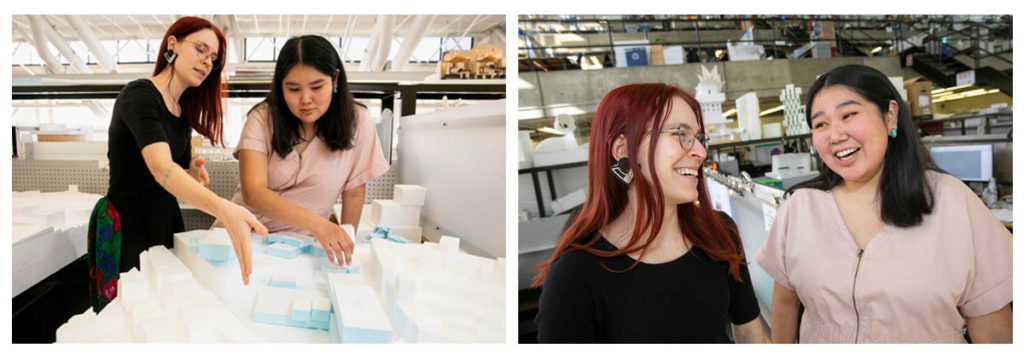
Elsa Hoover (left) and Zoë Toledo (both MArch ’23) discuss a model in the trays (the open, multi-tiered workspace) at Gund Hall. “Zoë and I first met when we were undergrads at Princeton and Columbia, at an All-Ivy Native Council Summit in 2014,” says Hoover. “From the moment Elsa and I learned that both of us had been accepted to the GSD, we realized how rare and powerful it would be for us as Native students to be able to find community,” Toledo adds. Photos by Jon Chase/Harvard Staff Photographer

Zoë Toledo sits at her desk in Gund Hall with a collection of quick sketches. She is Diné (Navajo) from Utah and is enrolled in a 3.5 year master in architecture program. “Native land and architecture lend themselves to nontraditional ways of building,” she says. “Native land offers so much more opportunity for investigation, as opposed to bringing pre-fab units into an area, without giving thought to how housing is integrated into the natural environment.” Jon Chase/Harvard Staff Photographer
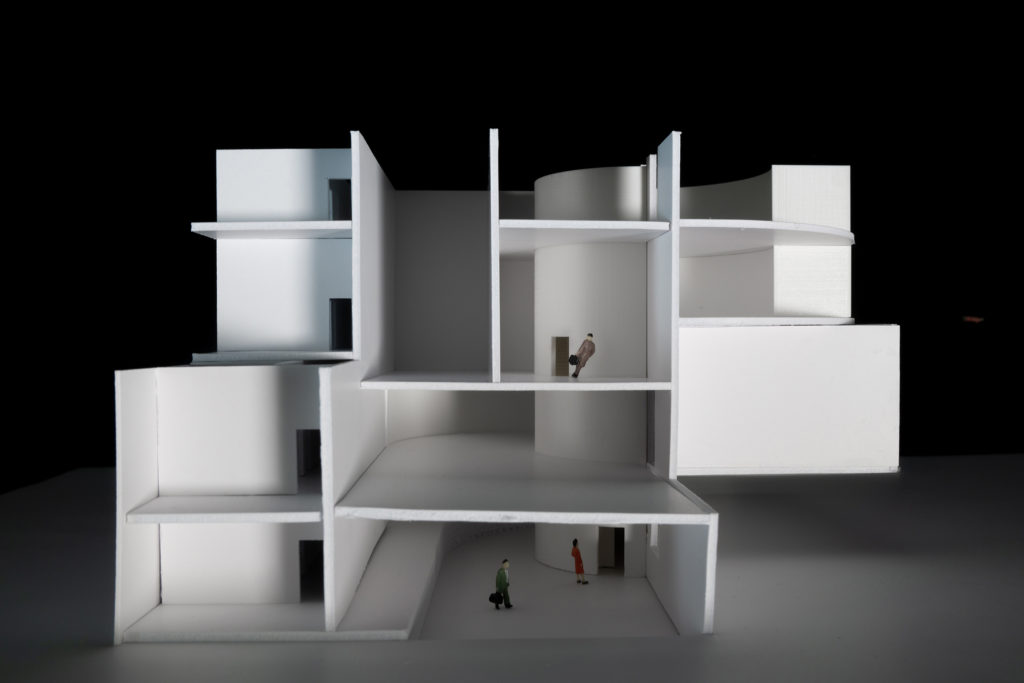
A model designed by Zoë Toledo. “My mother keeps asking me when I’m coming home, but I know why I’m here. I want to hone my skills in design to then go back and address the specific needs of my community,” says Toledo. Jon Chase/Harvard Staff Photographer

Heidi Brandow (MDes Art, Design, and Public Domain ’21) is both Navajo and Hawaiian. She stands by a chalkboard with Turkish script. Brandow studied industrial design in Turkey. She is currently taking a course in Turkish language at Harvard. Jon Chase/Harvard Staff Photographer
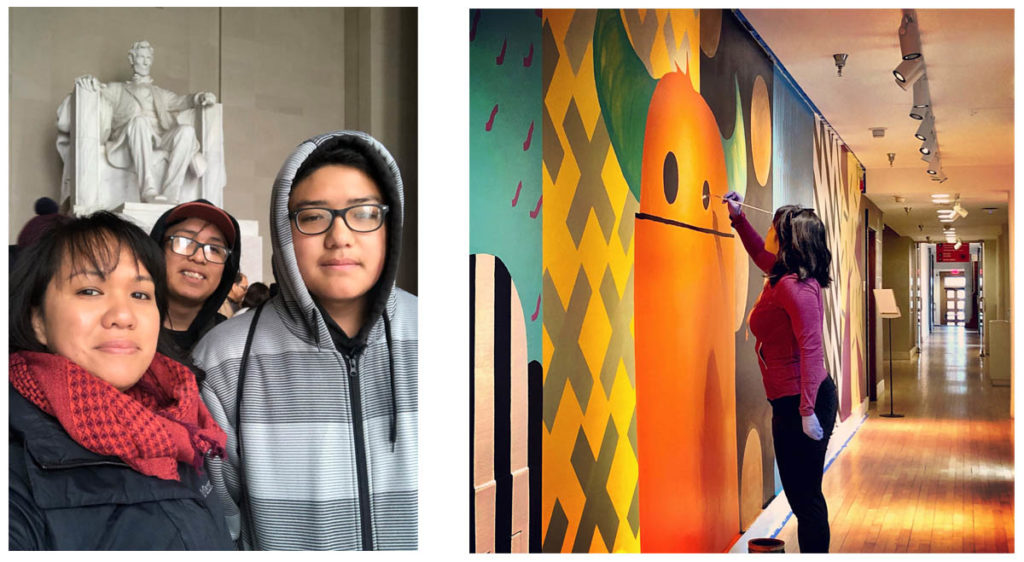
Heidi Brandow with sons Kian, 14, (center) and Mateo, 15. While attending the GSD in Cambridge, Brandow’s sons live with other family members 2,000 miles away in New Mexico. Brandow paints a mural at the Museum of Contemporary Native Arts in Santa Fe, N.M., in February 2019. “My research is centered on the inclusion of Indigenous people and perspectives in the development of ethical and sustainable methods of creative engagement. I intend on applying the experiences gained at the GSD toward working with Native communities,” she said. Photos courtesy of Heidi Brandow
An Anti-Racist Reading List: Five Essential Titles for Designers
How can design contribute to the fight against racism? As a place to start, the African American Design Nexus—an initiative developed by the Frances Loeb Library in collaboration with the GSD African American Student Union—has curated five essential titles for anti-racism reading. The recommendations come from a list of over 45 books on race and design crowdsourced from the GSD community in honor of the 50th anniversary of the first Black History Month celebrations. The open-access bibliography is designed to “showcase and initiate conversation about the work of Black designers throughout the world and to critically re-examine the legacy of racial discourses in modern and contemporary design thinking and practice.” It is a living document fueled by submissions from the GSD community. Learn how to submit a book or other printed media.For more recommended reading, visit A Call To Explore: Design, Race, and the Built Environment book suggestions from the GSD community.
The Fire Next Time
by James Baldwin
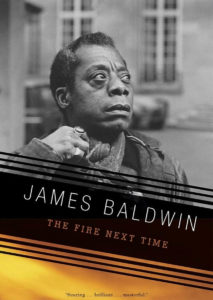 “At once a powerful evocation of James Baldwin’s early life in Harlem and a disturbing examination of the consequences of racial injustice, the book is an intensely personal and provocative document. It consists of two ‘letters,’ written on the occasion of the centennial of the Emancipation Proclamation, that exhort Americans, both Black and White, to attack the terrible legacy of racism.”
“At once a powerful evocation of James Baldwin’s early life in Harlem and a disturbing examination of the consequences of racial injustice, the book is an intensely personal and provocative document. It consists of two ‘letters,’ written on the occasion of the centennial of the Emancipation Proclamation, that exhort Americans, both Black and White, to attack the terrible legacy of racism.”
The Color of Law: A Forgotten History of How our Government Segregated America
by Richard Rothstein
 “Richard Rothstein describes how the American government systematically imposed residential segregation: with undisguised racial zoning; public housing that purposefully segregated previously mixed communities; subsidies for builders to create Whites-only suburbs; tax exemptions for institutions that enforced segregation; and support for violent resistance to African Americans in White neighborhoods.”
“Richard Rothstein describes how the American government systematically imposed residential segregation: with undisguised racial zoning; public housing that purposefully segregated previously mixed communities; subsidies for builders to create Whites-only suburbs; tax exemptions for institutions that enforced segregation; and support for violent resistance to African Americans in White neighborhoods.”
How to Kill a City: Gentrification, Inequality, and the Fight for the Neighborhood
by Peter Moskowitz
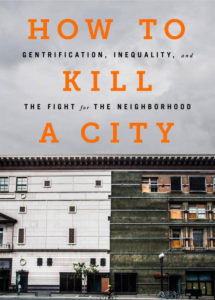 “Peter Moskowitz’s How to Kill a City takes readers from the kitchen tables of hurting families who can no longer afford their homes to the corporate boardrooms and political backrooms where destructive housing policies are devised. Along the way, Moskowitz uncovers the massive, systemic forces behind gentrification in New Orleans, Detroit, San Francisco, and New York.”
“Peter Moskowitz’s How to Kill a City takes readers from the kitchen tables of hurting families who can no longer afford their homes to the corporate boardrooms and political backrooms where destructive housing policies are devised. Along the way, Moskowitz uncovers the massive, systemic forces behind gentrification in New Orleans, Detroit, San Francisco, and New York.”
Black Faces, White Spaces: Reimagining the Relationship of African Americans to the Great Outdoors
by Carolyn Finney
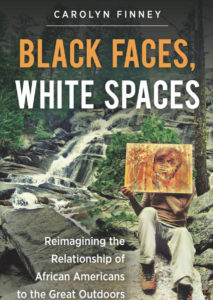
Killing Rage: Ending Racism
by bell hooks
 “Twenty-three essays written from a Black and Feminist perspective tackle the bitter difficulties of racism by envisioning a world without it. They address a spectrum of topics having to do with race and racism in the United States. In the title essay, hooks writes about the ‘killing rage’—the fierce anger of Black people stung by repeated instances of everyday racism—finding in that rage a healing source of love and strength and a catalyst for positive change.”
“Twenty-three essays written from a Black and Feminist perspective tackle the bitter difficulties of racism by envisioning a world without it. They address a spectrum of topics having to do with race and racism in the United States. In the title essay, hooks writes about the ‘killing rage’—the fierce anger of Black people stung by repeated instances of everyday racism—finding in that rage a healing source of love and strength and a catalyst for positive change.”
GSD Radio: Broadcasting Black Voices Daily at 8:30 PM EDT
Daily at 8:30pm we will be broadcasting a Black voice: a speech, interview, lecture, or other form of audio on the GSD Radio
Announcing faculty appointments and promotions in urban design, architecture, and landscape architecture
The Harvard University Graduate School of Design is pleased to announce the following faculty appointments and promotions effective July 1, 2020:

Charlotte Malterre-Barthes appointed Assistant Professor of Urban Design. Malterre-Barthes was previously guest professor in the Architecture Department of TU Berlin, Malterre-Barthes has directed, managed, and taught the post-graduate Master of Advanced Studies in Urban Design at ETH Zurich over the last six years. She is also co-founder of OMNIBUS, an urban design laboratory focused on interdisciplinary exploration of community-building factors in various metropolitans contexts. Charlotte’s teaching and research interests are related to how struggling communities can gain greater access to resources, the mainstream economy, better governance, and ecological/social justice. She believes that educators and universities have an obligation to be responsive to the challenges of our urbanizing world, equipping young practitioners and researchers with both critical skills and design tools to address them. Her pedagogy is built on a research-based design approach for identifying urgent aspects of contemporary urbanization. Charlotte holds a PhD in Architecture from ETH Zurich, and master’s and bachelor’s degrees in architecture from the National School of Architecture of Marseille (ENSAM).

Yasmin Vobis appointed Assistant Professor of Architecture. Vobis currently serves as visiting professor of architecture at The Cooper Union, and has previously taught at Princeton University and the Rhode Island School of Design. She sees the academy as an experimental platform for testing and exchanging ideas about architecture; rather than retreat from the issues of today’s political, social, and environmental context, her teaching aims to foster curiosity in these complexities and foster dialogue through design. Yasmin is co-principal of Ultramoderne, an award-winning architecture and design firm located in Providence, Rhode Island; the office is committed to creating architecture and public spaces that are at once modern, playful, and generous. Their view that architecture is not a boutique luxury, but plays an important role in all aspects of urban life, has driven them to mine the rich possibilities for contact between the discipline and the everyday. Yasmin received her bachelor’s degree from the University of California at Berkeley and her master’s degree from Princeton University’s School of Architecture.

Sara Zewde appointed Assistant Professor in Practice of Landscape Architecture. Zewde is a founding principal of Studio Zewde, a design firm practicing at the intersection of landscape architecture, urbanism, and public art. Sara’s practice and research start from her contention that the discipline of landscape architecture is tightly bound by precedents and typologies rooted in specific traditions that must be challenged. Sara most recently was Adjunct Assistant Professor at Columbia University’s GSAPP, and prior to that, she held an appointment as Race and Gender in the Built Environment Fellow at the University of Texas School of Architecture. She offers curriculum that is expressly connected to current sociopolitical debates, giving students an opportunity to actively take part in forming the links between their design education and the movements shaping the world they live in. Sara is a GSD alumna, specifically of the Department of Landscape Architecture; she also holds a master’s degree in city planning from MIT, and a bachelor’s degree in sociology and statistics from Boston University.

Stephen Gray promoted to Associate Professor of Urban Design. Gray has served as Assistant Professor of Urban Design since July 1, 2015. In addition to his role as Assistant Professor, Gray serves as the Co-Chair of the GSD Diversity Council. Gray also serves on the GSD Review Board, and is a coordinating faculty member for the GSD’s Design Discovery program.
Gray’s interests center on understanding political and cultural contexts of urban design; socio-ecological urban design approaches to resilience; and the intersectionality of humanitarian aid and urban design. His research and practice interrogate design’s contribution to, and complicity with, structural and infrastructural racism, and develop research and design methodologies that address issues of equity, access, social justice, and precarity at the scales of infrastructure, communities, metropolitans, and the globe.
Gray focuses his teaching primarily on the American city, and often on Boston and the Boston region. Gray’s courses include Elements of Urban Design and Cities by Design II, both of which Gray has been instrumental in re-orienting more explicitly toward questions of social equity, affordability, access, and socio-ecological resilience, as well as the political and procedural realities of urban design implementation. In Urban Design and the Color-Line, Gray interrogates urban design’s role in the production and elimination of structural racism and racial segregation in American cities. In 2015, he founded Grayscale Collaborative to further expand thinking and work at the intersection of urban design research and practice.
Gray earned a Bachelor of Architecture from the University of Cincinnati, and a Master of Architecture in Urban Design (MAUD) from the GSD, where he received the Thesis Prize for Urban Design and the Award for Outstanding Leadership in Urban Design. He has been tapped to serve on several Urban Land Institute (ULI) advisory panels, and has been nationally recognized by the American Institute of Architects (AIA) for his contributions to urban design thinking in the U.S. context with the National AIA Honor Award, the highest honor given to individual associate AIA members.

Holly Samuelson promoted to Associate Professor of Architecture. Samuelson has served as Assistant Professor of Architecture since July 30, 2013. In addition to her role as Assistant Professor, Samuelson serves as Co-Head of the Master in Design Studies in Energy and Environment. Samuelson also serves as one of the core faculty members for the Harvard Center for Green Buildings and Cities, and is a faculty advisor for the GSD’s Executive Education programs.
Samuelson’s research focuses on energy conservation and occupant behavior and health, utilizing computerized simulation to help the building industry mitigate and adapt to climate change while providing healthier spaces for occupants. Her work is characterized by a broad interdisciplinary lens and deep technical capacity on building performance simulation and its application/implication for architectural design and real estate. Samuelson’s courses include Environmental Systems in Architecture; Energy Simulation; Daylighting; and Environment, Economics, & Enterprise.
Prior to joining Harvard, Samuelson practiced full-time as a licensed architect and sustainable design consultant. As an architect, her work ranged in scale from a small museum for interactive art to a 100 acre master plan for Boston’s Fort Point Channel area with a primary focus on large-scale commercial buildings. She has worked on dozens of LEED projects and taught LEED workshops nationally and abroad. Her collaborative design work has been featured in the Boston Globe and honored by the Boston Society of Architects.
Samuelson earned a Doctor of Design and Master in Design Studies with distinction from the GSD, where she was awarded the Gerald M. McCue medal. She earned a Bachelor of Architecture with honors from Carnegie Mellon where she was awarded the American Institute of Architects Henry Adams Gold Medal. She has contributed articles to Building and Environment, The Journal of Building Performance Simulation, and The Journal of Environmental Management.
Can technology enable site-specific knowledge? A studio examining transformations in rural China tests the limits of remote ethnography
Last March, the option studio I led with Kathryn Firth and David Rubin, Taishan: Designing the Rural Cosmopolis in China, suddenly found itself on the forefront of a design research challenge. With the outbreak of the COVID-19 virus, classes became virtual seemingly overnight and research by necessity became remote. But when research is based on site-specific knowledge of a place and pedagogy requires deep immersion and understanding of a local transformation, how could we draw strong conclusions from so far away?
In lieu of their scheduled trip to China in March, students enlisted a suite of new tools to help them research developments in Taishan. Through the use of survey apps, video chat, and online mapping tools, student teams were able to conduct remote ethnography in a way that allowed Taishan citizens to voice their perspective and students to integrate real scenarios into their design proposals. As design challenges continue in the studio, our daily lives, and abroad, how can connections afforded by technology offer unique opportunities to innovate, connect, and continue collaborating?
Elaine Kwong is a Chinese-American urban designer based in Los Angeles. She directs DESAKOTA and teaches architecture and urban design. Elaine is currently a faculty member at Harvard University, Graduate School of Design and University of Southern California, School of Architecture.

